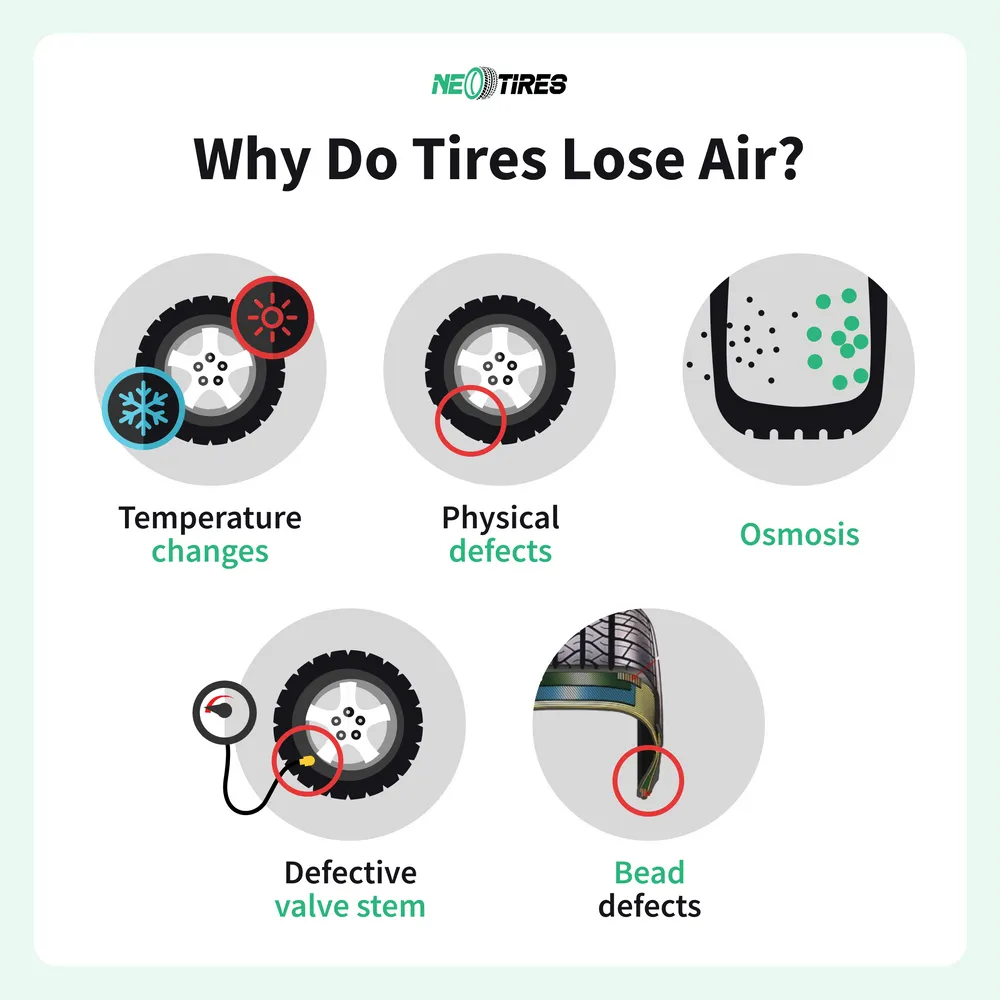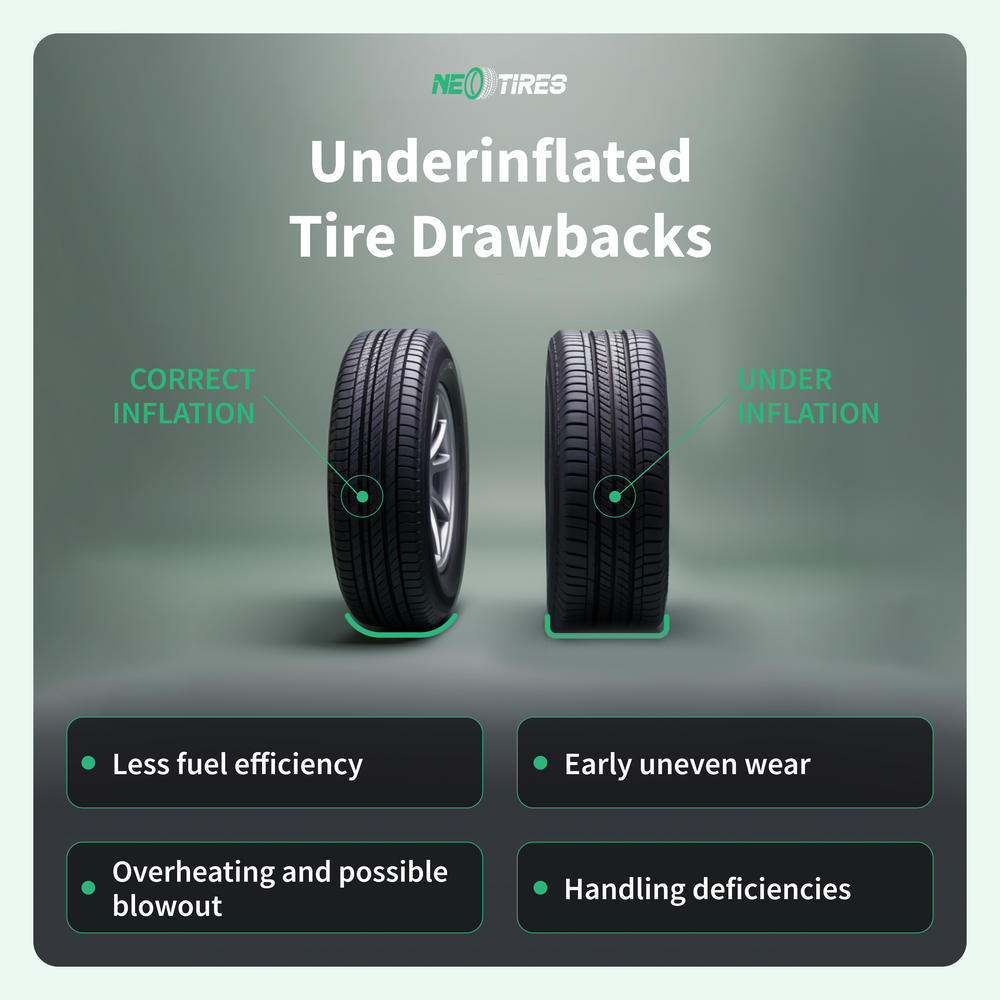Low tire pressure is one of the most common issues drivers face. Tire underinflation significantly impacts vehicle performance, fuel efficiency, and driving safety. This article discusses the causes and consequences of tire low-pressure, how to manage it, and related frequently asked questions.
What Is Tire Underinflation?
Tire underinflation occurs when the tire's air level falls below the manufacturer's recommendations by more than 25% (that's where the TPMS light comes on). For example, a tire is considered underinflated at 24 PSI if the recommended pressure is 32 PSI.
Low air levels make the contact patch between the tire and the ground bigger than usual, leading to increased friction, tire blowout, premature wear, higher fuel consumption, and performance issues (increased braking distance, higher risk of rollover, and poor weight distribution).
Causes of Tire Underinflation
Five factors lead to tire underinflation: osmosis (natural air loss), temperature changes, valve stem defects, tire physical defects (punctures and leaks), and bead defects.
| Why Do Tires Lose Air? | Explanation |
Natural Air Loss | Tires lose air naturally through the osmosis process (gas molecules passing through the rubber). Tires can lose about 1-2 PSI per month, on average, even without temperature fluctuations or other underlying causes. |
Temperature Fluctuations | Tire loose PSI with seasonal temperature swings, especially during cold weather, due to air compression inside. Drivers can expect a drop of 1 PSI with every 10°F in temperature. |
Valve Stem Defects | A tire loses air if the valve stem is damaged (physical cracks, sitting at an odd angle, visible wear at its base). The tire pressure can go low gradually or suddenly, depending on the valve stem damage degree. |
Punctures and Leaks | Tire low pressure can be expected with small punctures in the tread or other defects on the tire sidewall. Air leakage can be gradual and slow. Regular tire checks can help detect them early to solve the air deflation. |
Bead Defects | Tire air loss can occur due to corroded beads, creating tiny gaps for air leaks. It also can occur when debris, rust, and other road material get trapped between the rim and bead, creating a path for air to escape. |
What Can Happen With Tire Underinflation?
Four critical issues are to be expected with tire underinflation: lower fuel efficiency, poorer handling, early and uneven tread wear, and higher risks of blowouts.
- Lower Fuel Efficiency
Low tire pressure reduces tire rolling resistance, forcing the engine to work harder. According to the U.S. Department of Energy, driving on underinflated tires reduces gas mileage by 0.2% for every 1 PSI drop in all four tires.
- Poorer Handling and Stability
Tire underinflation impacts vehicle stopping distance and compromises vehicle handling, especially while cornering. According to the NHTSA, the stopping distance can increase by 10% to 20% with underinflated tires.
- Uneven Tire Wear
Underinflated tires cause uneven tread wear, particularly on the outer edges. This reduces tire lifespan and increases replacement costs.
- Higher Risk of Blowouts
Low tire pressure increases friction, leading to tire heat build-up and, thus- increased blowout risks. Driving at high speeds on highways on underinflated tires is especially dangerous.
How to Detect Underinflation
To detect tire underinflation, consider performing regular visual inspections to spot flatter-than-usual tire shapes, particularly on the outer edges. A manual pressure check with a pressure gauge once a month is also helpful to compare the readings with the recommended air levels (found on the driver's door jamb). Most modern cars in the U.S. alert drivers about low tire pressure through the TPMS.
Tire Underinflation: FAQs
How Do I Know If My Tire Is Underinflated?
Signs of tire underinflation include: tire shape is visibly flatter at the bottom; delayed steering response than usual; longer stopping distance; excessive wear on the outer tire edges; the tire feeling soft when pressed by hand; lower fuel efficiency; TPMS light on.
What Can Happen With Tire Underinflation?
Low tire pressure leads to a higher wear rate, especially on the outer edges, lower handling/braking performance, a risk of tire failure due to heat build-up, and higher rolling resistance, which in turn leads to higher fuel consumption.
Is It Better To Overinflate Or Underinflate Tires?
None of them is beneficial. While overinflation is hazardous because there is less contact patch on the road, underinflation leads to tire edge wear, high risks of a blowout, less MPG, and handling issues. For safety and performance reasons, stick to your manufacturer's pressure recommendations.
How Many PSI Will a Tire Lose Per Month?
Usually, tires lose about 1-2 PSI per month due to osmosis (natural air loss). Factors like temperature fluctuations, tire age, tire damage (punctures), valve stem issues, extra load, or rough terrain driving can bring about more pressure loss.
| Factors for Tire PSI Loss | How Many PSI | Reason |
| Temperature Fluctuations | 1-2 PSI loss for every 10°F drop in temperature. | Cold weather makes the air inside the tire contract, reducing pressure. |
| Age of Tire | Gradual loss: 0.5-2 PSI per month, depending on tire condition | Older tires tend to lose air more quickly due to wear and potential degradation of the rubber and valve. |
| Tire Damage | Loss depends on the severity; can be rapid or slow. | Small punctures may cause slow leaks, while larger cuts lead to immediate loss of PSI. |
| Heavy Load | Loss can vary; typically 1-3 PSI per 100 pounds of additional weight. | Carrying heavy loads causes tires to flatten more, leading to pressure changes. |
| Driving on Rough Terrain | Can cause 0.5-2 PSI loss due to impacts. | Driving over rough roads can cause minute leaks or shifts in the tire's integrity, leading to slow air loss. |
| Valve Stem Issues | Slow loss over time: 0.1-1 PSI per week or more, depending on the damage | A faulty or damaged valve stem can cause air leakage, especially if it's cracked, corroded, or improperly sealed. |
Underinflated Tires Cost You More Than You Think!
Tire underinflation leads to poor fuel efficiency, safety risks, and uneven tread wear. If your tires do not maintain air properly, it may be time for a replacement.
At NeoTires, you can find reliable products to provide grip, traction, and safety. Explore our catalog or contact our assistants for personalized suggestions!
Why Trust Us?
NeoTires is a team of specialists who want and can improve the driving experience of every motorist. We are here to help you find the right products to have safe and performant driving in any condition, offering a wide variety of products from the most reliable brands in the industry. Bridgestone, Pirelli, Hankook, Goodyear, Dunlop, Firestone, Cooper, and many other tire makers are available at reasonable prices in our online store.
In addition to our wide range of products, we offer the necessary qualified assistance. The NeoTires team members have extensive experience in the automotive field and can help you choose the right products professionally according to your specific needs.
Welcome to NeoTires, whether you need good tires at reasonable prices or qualified informational support. Drive safe and choose your tires wisely!







